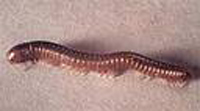|  Millipedes Millipedes
Order: Diplopoda
Family: Various
Scientific Name: Various
Color: Blackish or brownish
Legs: Most body segments have 2 pairs of legs
Shape: Body cylindrical and wormlike
Size: 1/16-4 1/2" long
Antennae: Yes
Flight: No
Millipedes are sometimes called "thousand leggers", but
they usually have 30-90+ pairs of legs. They are widely distributed
throughout the United States and most of the world, with about 1,000
species occuring in the U.S.
Habits
Millipedes spend the winter as adults in protected habitats and
become active in the spring. During the warmer months, females lay
eggs in soil and cover them with a sticky substance, although some
species give birth to living young. Millipedes develop through about
seven stages (instars) in 21 to 25 weeks.
Habitat
Millipedes prefer to live in moist habitats and during the day stay
underneath rocks, logs and other objects in contact with the ground.
They are active at night. Millipedes feed on decomposing organic
matter, but will occasionally damage seedling plants by feeding
on leaves, stems and roots. They curl up tightly when disturbed
resulting frequently in the release of fluids from repugnatorial
glands.
Threats
Millipedes do not bite; but when disturbed they can produce an irritating
fluid (using repugnatorial glands opening at the base of the legs).
This fluid can irritate eyes, blister the skin, produce an unpleasant
odor and cause allergic reactions in venom sensitive people. Some
species can squirt their fluids several inches. Millipedes, such
as the garden millipede (Oxidus gracilis, Polydesmida: Paradoxosomatidae),
can become numerous in the greenhouse and damage crops. They may
invade homes during cooler weather.
Control
Controlling millipedes outdoors includes removing objects that provide
harborage such as trash piles, rocks, boards, leaf piles, compost
piles and similar materials. If millipedes occur in great numbers
or are creating problems, appropriately labeled sprays or dusts
may be used.
(Source: National Pest Management Association, et. al.)
|